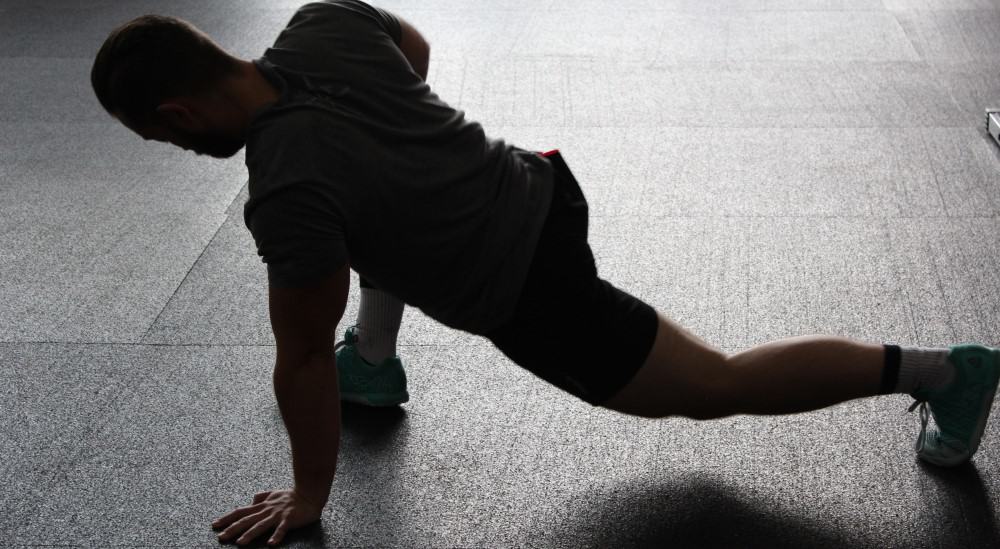Stretching? A very questionable topic for many athletes.
But does stretching impact athletic performance?
Stretching for injury prevention reasons seems to be very useful. Still, there are some athletes who loathe stretching.
But what about the latest scientific findings on the topic? Which forms of stretching are there and what effects does it have on muscle growth? In this article, we will explore the subject of stretching and everything that goes with it.

Forms of Stretching
Stretching describes the extension of the muscle by movement. Here we distinguish two types of stretching:
1. Static stretching
2. Dynamic stretching
Static Stretching
In static stretching, the muscle is brought into a stretched position, where the origin and attachment of the muscle are deliberately removed from each other.
Afterward, the athlete stays in the position for 30-60 seconds.
Static stretching has several variations:
1. Active (self-stretching)
2. Passive (external stretching)
3. PIR technique (international Post-Isometric Relaxation)
Dynamic stretching
Dynamic stretching is characterized by soft, roaring movements in a stretched position.
Also in dynamic stretching, the origin and attachment of the muscle are removed from each other.
The essential difference to the static stretching lies in the short residence time in the end position.
You can include dynamic stretching, due to rhythmic movements, to the Mobility category.
What is the optimal stretching duration and frequency?
Due to the high level of effort and pain, stretching and mobility are often neglected and circumvented by many athletes.
But what does the current data on the stretching say? does it improve athletic performance?
It turned out that the most positive effects of stretching disappear after only 30 minutes.
In order for the athlete to benefit from the positive effects in the long term, a stretching program of at least three times a week is required.
The duration is between 10-60 seconds and the stretching is carried out two to four times.
A static stretch of 60 seconds is controversial. If you want to be on the safe side, you can’t do much wrong with stretching for max 60 seconds.

The perfect duration depends on the individual.
We have now covered various forms of stretching, strain duration, and strain rates.
Now, we will focus on the effects of different stretches in the muscle. We deal with the relationships of strength training and stretching and athletic performance.
How does Stretching Effect Muscles?
First things first, stretching tolerance is the determining factor in relation to the effects in the muscle.
The body adapts to the neurophysiological changes that occur during stretching. This results in a reduced pain sensation for the identical muscle length. According to the latest scientific findings, there is no prolongation of the muscle, as it has long been assumed.
Meaning, the stretching tolerance is the crucial point, which is sensory and central and not mechanical.
Can Strength Training Positively Influence the Ability to Stretch?
Muscles can be stretched in all possible ways.
However, the most important component of stretching in weight training is the eccentric easing of the muscle. The eccentric relaxation of a muscle is always associated with the concentric contraction of an antagonist.
Example
When performing a bicep curl, the biceps brachii muscle, in the upward movement of the dumbbell, concentrates, and tenses. In return, the M. triceps brachii eccentrically, coming closer to its end position of the extension and is stretched.
In order for the athlete to benefit from strength training in terms of elasticity, a full ROM (Range of Motion) is required. If the maximum ROM is given, the athlete benefits enormously from strength training.
He will not only strengthen his muscles but also his ability to stretch.
We have clarified how strength training can positively influence the mobility of the muscle. Let’s take a look at athletic performance. We will clarify whether athletes can benefit from a stretching program before training.
The Influence of Stretching on the Performance of Athletes
Various studies have shown that static stretching before weight lifting has a negative impact. Especially after a stretching time of 45 seconds or more.
Increased stretching tolerance makes the muscles more flexible. This results in an increased range of motion, reduced stability, and a reduced balance, but also a reduced maximum and explosive power.
There is a possibility that static stretching has no influence on the subsequent performance of an athlete.
But only if there is a warm-up phase or warm-up exercises following the stretch. Thus, performance reduction can be prevented.
Particularly suitable: treadmill, cross-trainer, Stairmaster, but also a few warm-up sets on the exercise itself.
Remember:
The shorter the stretching time before the exercise, the lower the power reduction will be.
Is Dynamic Stretching before Performance Better than Static Stretching?
Dynamic stretching has a less negative impact on performance and performance, according to current data.
Some studies, show neither advantages nor disadvantages from stretching. But also for the dynamic stretching, the effectiveness always depends on the respective person.
If you feel more comfortable with a pre-workout stretching program, you will probably perform better. Mindset plays a major role.
Some people swear by their weird pre-workout routines. But as long as it works for them, fine.
The same applies to stretching.
Important Aspects of Dynamic Stretching
It is important that you do not overtax the muscle before exercise. The stretching time, set and repetition number is individually dependent on the athlete.
In addition, the stretching rate should be fast, highly dynamic. Otherwise, it’s basically the same than a static stretch.
The dynamic stretching in the end position of an exercise, for example, a paused squat, is better than a simple extension program.
Dynamic stretching acts as a kind of warm-up program. The heart rate is increased and the body temperature rises.
All in all, there are effects of stretching on athletic performance. I also showed you the best approach to dynamic pre-workout stretching.
Now, we will focus specifically on stretching for injury prevention, muscle soreness, and pain. When and why the stretching of the muscles can be useful for athletic performance.
Stretching against Sore Muscles?
In the meantime, various meta-analyses and studies have shown that stretching has no effect on sore muscles.
This myth arose from the assumption that the muscles cramp when sore. By stretching the blood flow is stimulated, which releases the cramps.
Another myth that has been around for a long time is lactate accumulation in anaerobic stretching. It’s wrong.
Today we know that sore muscles describe a kind of subclinical inflammatory reaction. This is caused by the tiny microtrauma in the sarcomeres.
The sarcomere describes the smallest functional unit of muscle fiber, which is part of the musculature.
The microtrauma is caused by a progressive overload on the muscle. For this reason, stretching does not have a positive impact on the symptoms such as pain, weakness, and stiffness.
If you need a basic guide for muscle growth at this point, check out our Free Emerging Athlete Guide.
Stretching for Pain Release
Studies have shown that there is a connection between stretching and pain release.
However: “There is not the one optimal exercise for everyone.”
All persons have different preferences for stretching exercises. Which exercise promotes pain relief is highly individual. So go try some stretches for yourself and see what feels right.
The exercise itself takes only a secondary position!
Does Stretching reduce Risk of Injury?
Stretching before exercising has no significant positive impact on reducing the risk of injury.
In return, strength training can reduce the risk of injury by about 30%. This probably results from the eccentric stretching during the exercises.
Common Types of Stretches
1. Sumo Squat Stretching
Stretches the hamstrings, buttocks, and back.
Stand legs apart, feet slightly outward. With a straight back in the go in a deep squat position, the heels remain on the ground. The arms between the knees are stretched, the hands surround the toes. Stretch your legs slowly, hands on your feet. Bend over the upper body. Hold. Back. Hold. Back.
2. Quad Stretching with Lunges
Stretches the quads and buttocks.
Stand upright and legs shoulder width. Make a maximum lunge to the front, with the left foot. Support the hands on the left thigh. Then change sides.
3. Calve stretching standing with bent leg
In the step position, the right foot is at the front, set about shoulder width. Slightly bend the left leg, place the foot firmly on the ground. Bend the right leg a little, also put the heels firmly on the ground. Support the hands on the right thigh and keep the upper body straight.
4. Lunges with side bends
Stretching the hip, the lateral abdominal muscles, and the large back muscle.
Hip width stands upright and clenches your hands into fists. Tighten the torso. Take a long step forward with the right foot and bend the knee at right angles. Spread the arms to the side and tilt the straight trunk to the right until the right hand almost touches the floor and the left one faces the ceiling. Keep the hip stable. Hold briefly, back and run to the other side. Continue alternately.
5. Two-armed chest stretching
Stretches the chest.
Stand upright and shoulder width in front of a wall. Stretch the arms diagonally upwards and support them with the palms on the wall. Bent the upper body until you feel an expansion in the chest muscles.
Conclusion: Stretching for Athletic Performance
Stretching, unfortunately, has less positive effects than expected. However, every athlete should evaluate whether he integrates it into his everyday life or the training or not.
My personal opinion is that stretching is appropriate in some situations. However, the focus of ambitious athletes should be on strength training. Many positive effects of stretching can be achieved through strength training.
However, an additional stretching program on separate days is not reprehensible.
A stretching program before the actual training makes sense only if the athlete feels better afterward.
It is important that dynamic stretching is preferred over static stretching.
If the athlete implements a stretch before exercising, a subsequent warm-up makes sense.
Weight training athletes do not need a separate stretch when training in the full range of motion. Unless they suffer from any special problem in the form of a restriction of movement.
The importance of stretching for a specific person depends especially on the limitations of movement and the problem.
Athletes with ideal ranges of motion will not benefit significantly from stretching before in weight training.
Cheers,
Sam
Do you Stretch before Workouts?




